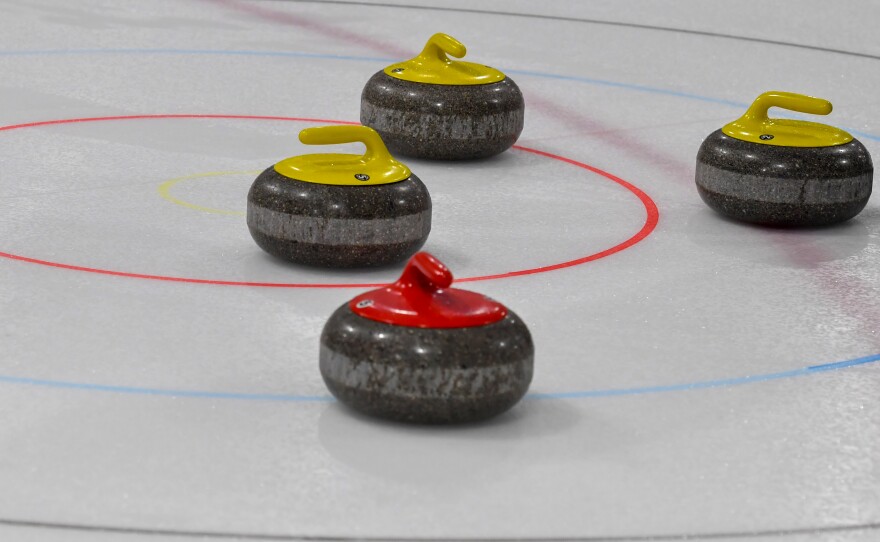Dave Cawley grew up in Buffalo, New York, and watched curling on Canadian TV. He went to King’s College, got married and stayed in Northeastern Pennsylvania.
“I said to my brother in law ‘we've got ice, I play hockey here, we should start a curling club.’ But he looked at me and said ‘what the hell is curling?’” Cawley said.
He showed Matt Lyons videos of the sport.
“He said ‘that's stupid enough, I could do that,’ and so we decided to start a curling club," Cawley said.
Lyons laughed. He shared the same story but used stronger language.
Cawley, Lyons and Cawley’s daughter formed the Scranton Curling Club in 2006. A few years later, they changed their name to the Anthracite Curling Club to be more inclusive of the area. The club's season just began. They play on Tuesdays at the Toyota Sports Plex in Wilkes-Barre.
The number of people who come out to curl depends on the year. If the winter Olympics are on, people become intrigued by the unusual sport. They search for curling clubs online and find Anthracite. The league plays in tournaments around the East Coast but mostly play against each other on the ice in Wilkes-Barre.
It’s like stepping back into winter inside the Sports Plex on a hot spring Tuesday. Some of the curlers wore coats and winter hats.
Each team has four members. Each player throws two stones per end. The end is like an inning in baseball. It can last about 2 hours.
The stone is made of a specific type of granite from a small island off the coast of Scotland. It weighs 42 pounds and has either a red or yellow handle. It’s cast by sliding your left foot and the stone forward, pulling both back and then launching yourself to slide with the stone on the ice. Lyons described the position as warrior one in yoga. Your left knee is bent while your right leg stretches back behind. The stone has to be released before a thin blue line on the ice.
There’s four rings on the ice, about 145 feet from each other. The goal is to get the stone closest to the center ring. It’s called the button.
“If you've ever heard the term right on the button, that is a curling term,” said Cawley.
The skip is the team’s captain. They stand in the rings at the other end of the ice and point and tap with their broom to direct where the stone should go.
Then team members start vigorously sweeping. Water is sprayed on the ice before the game begins. It’s called pebbling. The sweeping clears debris out of the way and smooths out the pebbles to give the stone more glide.
“Even something like a human hair can make it change direction,” said Cawley.
They can’t touch the stone. If they do, it’s called a burned stone.
Curlers walk between 2 and 3 miles per game. The field of play is over 145 feet.
The end wraps up when all the stones have been cast.
The sport began in Scotland in the 16th century. Cawley said it’s a descendant of the Roman game bocce. Actual brooms were used at first to sweep the ice. Now they have a flat textured surface.
Jason Snyder is the club’s president. He found curling, like many people do, through the winter Olympics and an internet search.
“It's the game, the fellowship, just talking to the people, and just having fun out there,” he said. “It's competitive, but it's not like it's cutthroat.”
Curling was added to the winter Olympics in 1998. But long before then, the first curling club popped up in the United States around 1840 in Michigan. At the turn of the 20th century, there were at least seven curling clubs in Northeastern Pennsylvania and the Scranton Curling Club is mentioned as far back as 1871, according to newspaper archives. They competed at an ice rink at Rocky Glen.
Lyons said the Wilkes-Barre club disbanded in 1906, 100 years before the current club in the city began.
Anthracite is always open to new members.
“If somebody just walks in off the street one day while we're in the middle of a league, we'll show you how to play. We want everyone to learn how to play,” said Cawley.
Cawley said you don’t need anything to start out. There is a membership fee which helps pay for insurance and equipment. Tuesday nights are their league night.
“It's fun … it's like any other recreational sport, some weeks you wonder why you keep coming back, because it's really frustrating,” he said. “And then other weeks, you have a good game and you think you're, you know, the greatest curler in the world.”
For more details, visit https://anthracitecurling.com/













